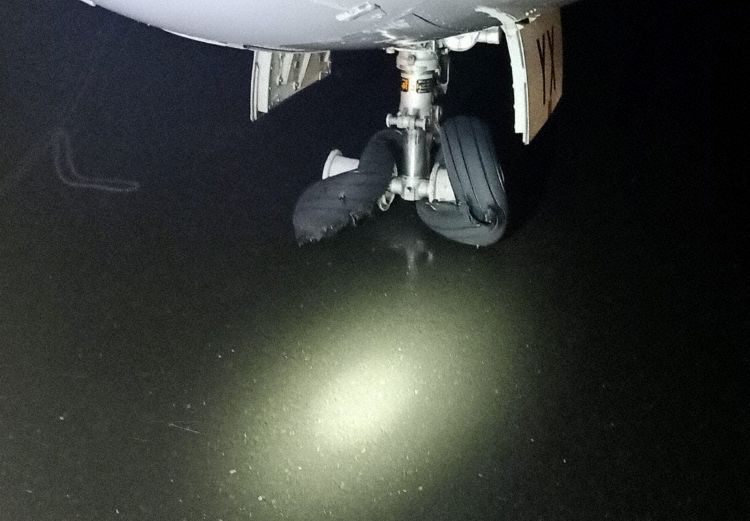An Indigo Avions de Transport Regional ATR-72-212A, registration VT-IYX performing flight 6E-7979 from Kannur to Hubli (India) with 7 passengers and 4 crew, was on final approach to Hubli's runway 26 at 20:00L (14:30Z) when after touchdown the crew decided to reject landing due to strong gusting crosswinds and went around. The aircraft entered a hold and performed another approach to runway 26 about 30 minutes later and landed without further incident, but became disabled on the runway due to both nose gear tyres blown.
The runway was closed for about 4 hours until the aircraft could be moved off the runway.
The airport reported the aircraft performed a balked landing due to heavy winds and bad weather and landed about 30 minutes later. Soon after touchdown the crew reported they suspected blown tyres and stopped on the runway. 18 passengers booked onto the onward leg to Bangalore were delayed due to the cancellation of the onward sector.
On Jun 24th 2021 India's AIB reported: "The aircraft made a balked landing at Hubli airport. After landing, both nose gear tires burst." and rated the occurrence a serious incident. The occurrence is under investigation.
Some time in the past India's AIB released their final report concluding the probable causes of the accident were:
The probable cause of this accident is attributed to inappropriate aircraft landing technique and not following the bounced landing recovery procedure i.e., delayed flare, high speed at touchdown and delay in initiating a Go-Around.
Contributory factors for this accident were lack of situational awareness and lack of commitment to initiate a Go-Around after experiencing a significant bounce.
The AIB reported the captain (57, ATPL, 5999 hours total, 252 hours on type) was pilot flying, the first officer (31, CPL, 980 hours total, 740 hours on type) was pilot monitoring.
The AIB analysed (amongst others):
The aircraft carried out a non-precision approach on runway 26. Between 30ft RA to 5ft RA, elevators were deflected in both nose up and down orders. The resultant deflection was a nose down order. Pitch angle was -0.3° at 10ft RA and then reduced to -2.3° at 5ft RA. IAS was 111kt. At 5ft RA, power levers were retarded to FI.
Due to delayed flare, higher IAS than targeted speed (+13 than Vapp)and pitch angle -0.3° aircraft touched down with a VRTG of +1.9 G. Due to nose down attitude of the aircraft, the touchdown was three pointers i.e., all three gears got compressed simultaneously. This was an undesired landing attitude of the aircraft. However, instead of initiating a Go-Around, nose down order was applied, as the PF was trying to settle down the aircraft anyway. Consequently, aircraft bounced in air. However, PF kept on applying nose down order.
Then the second touchdown occurred on nose landing gear first with -2.0° of pitch angle, VRTG +1.5 G. This time the PM gave a call for Go-Around, but PF did not agree and replied Hold Hold. The PF intentions were clear of settling down the aircraft instead of initiating a Go -Around. Aircraft encounter another bounce and PF kept on applying the nose down order.
The third touchdown also occurred on nose landing gear first with -3.7° of pitch angle, a VRTG +1.8 G and again elevators nose down order. A Go-Around call given by the PM was disagreed by PF. This further clarifies that PF was not committed to initiate a Go-Around. Aircraft encountered another bounce.
The fourth touchdown occurred. The aircraft touched down on nose landing gear first a third time. This time pitch angle was -5.9°, a 3.3 G vertical and 0.4 G lateral. Then a dual input registered in the DFDR indicates PM took the control to initiate a much awaited Go-Around. However, the dual inputs were mainly in the same direction. This time aircraft bounced and Go-Around was initiated simultaneously.
The crew initiated a Go-Around, only after the fourth touchdown. During Go-Around landing gear unsafe procedure was displayed for 20 sec. However, the indication was not noticed by the crew. When the landing gears were selected up, the landing gear unsafe indication cleared automatically. Aircraft climbed as per ATC instruction and entered a holding pattern and carried out two right orbits. During hold crew discussed diversion to Bengaluru and also enquired the weather from ATC Hubli. ATC Hubli reported raining over the field and runway wet.
Later at 14:53:33 UTC, crew again enquired about raining condition, ATC Hubli, responded light drizzling Sir. Thereafter, crew requested for approach and ATC cleared the aircraft for approach to runway 26.
During second approach on the same runway 26, when the landing gears were selected down, landing gear unsafe procedure was displayed again. Crew noticed the indication this time. Crew followed QRH procedure and disregarded the unsafe indication. Checklists were carried out and the landing phase initiated. When the aircraft was established on approach track runway 26, ATC Hubli, passed the METAR to the aircraft.
On landing, aircraft touched down on MLG with +3.3° of pitch angle, power lever were at FI just before touchdown and the IAS was less than Vapp target. However, VRTG was high(+1.9 G) and aircraft bounced. PM gave a call for Go-Around PF replied No, Hold. Aircraft bounced. A second touched down occurred on with +0.3° of pitch angle and both power lever were at FI. However, VRTG was again high. Aircraft bounced again. Subsequently third touched down occurred followed by another bounce. Aircraft touched down fourth time. However, VRTG was less than 1.5G. When the nose landing gear wheel touched down, crew observed a grinding noise and vibration.
Therefore, the crew stopped aircraft on the runway and informed ATC Hubli of a suspected nose wheel tyre burst and switching off engines on the runway itself. At 15:04:08 UTC, finally the aircraft came to rest approx 1300m of the runway threshold.
Metars:
VOHB 150030Z 28009KT 6000 SCT008 SCT012 BKN080 22/21 Q1007=
VOHB 141200Z 24010KT 9999 SCT008 SCT012 BKN080 24/22 Q1007=
VOHB 141100Z 26009KT 9999 SCT008 SCT012 BKN080 25/21 Q1006=
VOHB 141000Z 24008KT 9999 SCT010 SCT015 BKN080 26/20 Q1006=
VOHB 140900Z 24009KT 9999 FEW010 SCT015 BKN080 26/20 Q1007=
VOHB 140800Z 25011KT 9999 FEW010 SCT015 BKN080 26/20 Q1007=
The nose gear tyres (Photo: Tarun Shukla):

The runway was closed for about 4 hours until the aircraft could be moved off the runway.
The airport reported the aircraft performed a balked landing due to heavy winds and bad weather and landed about 30 minutes later. Soon after touchdown the crew reported they suspected blown tyres and stopped on the runway. 18 passengers booked onto the onward leg to Bangalore were delayed due to the cancellation of the onward sector.
On Jun 24th 2021 India's AIB reported: "The aircraft made a balked landing at Hubli airport. After landing, both nose gear tires burst." and rated the occurrence a serious incident. The occurrence is under investigation.
Some time in the past India's AIB released their final report concluding the probable causes of the accident were:
The probable cause of this accident is attributed to inappropriate aircraft landing technique and not following the bounced landing recovery procedure i.e., delayed flare, high speed at touchdown and delay in initiating a Go-Around.
Contributory factors for this accident were lack of situational awareness and lack of commitment to initiate a Go-Around after experiencing a significant bounce.
The AIB reported the captain (57, ATPL, 5999 hours total, 252 hours on type) was pilot flying, the first officer (31, CPL, 980 hours total, 740 hours on type) was pilot monitoring.
The AIB analysed (amongst others):
The aircraft carried out a non-precision approach on runway 26. Between 30ft RA to 5ft RA, elevators were deflected in both nose up and down orders. The resultant deflection was a nose down order. Pitch angle was -0.3° at 10ft RA and then reduced to -2.3° at 5ft RA. IAS was 111kt. At 5ft RA, power levers were retarded to FI.
Due to delayed flare, higher IAS than targeted speed (+13 than Vapp)and pitch angle -0.3° aircraft touched down with a VRTG of +1.9 G. Due to nose down attitude of the aircraft, the touchdown was three pointers i.e., all three gears got compressed simultaneously. This was an undesired landing attitude of the aircraft. However, instead of initiating a Go-Around, nose down order was applied, as the PF was trying to settle down the aircraft anyway. Consequently, aircraft bounced in air. However, PF kept on applying nose down order.
Then the second touchdown occurred on nose landing gear first with -2.0° of pitch angle, VRTG +1.5 G. This time the PM gave a call for Go-Around, but PF did not agree and replied Hold Hold. The PF intentions were clear of settling down the aircraft instead of initiating a Go -Around. Aircraft encounter another bounce and PF kept on applying the nose down order.
The third touchdown also occurred on nose landing gear first with -3.7° of pitch angle, a VRTG +1.8 G and again elevators nose down order. A Go-Around call given by the PM was disagreed by PF. This further clarifies that PF was not committed to initiate a Go-Around. Aircraft encountered another bounce.
The fourth touchdown occurred. The aircraft touched down on nose landing gear first a third time. This time pitch angle was -5.9°, a 3.3 G vertical and 0.4 G lateral. Then a dual input registered in the DFDR indicates PM took the control to initiate a much awaited Go-Around. However, the dual inputs were mainly in the same direction. This time aircraft bounced and Go-Around was initiated simultaneously.
The crew initiated a Go-Around, only after the fourth touchdown. During Go-Around landing gear unsafe procedure was displayed for 20 sec. However, the indication was not noticed by the crew. When the landing gears were selected up, the landing gear unsafe indication cleared automatically. Aircraft climbed as per ATC instruction and entered a holding pattern and carried out two right orbits. During hold crew discussed diversion to Bengaluru and also enquired the weather from ATC Hubli. ATC Hubli reported raining over the field and runway wet.
Later at 14:53:33 UTC, crew again enquired about raining condition, ATC Hubli, responded light drizzling Sir. Thereafter, crew requested for approach and ATC cleared the aircraft for approach to runway 26.
During second approach on the same runway 26, when the landing gears were selected down, landing gear unsafe procedure was displayed again. Crew noticed the indication this time. Crew followed QRH procedure and disregarded the unsafe indication. Checklists were carried out and the landing phase initiated. When the aircraft was established on approach track runway 26, ATC Hubli, passed the METAR to the aircraft.
On landing, aircraft touched down on MLG with +3.3° of pitch angle, power lever were at FI just before touchdown and the IAS was less than Vapp target. However, VRTG was high(+1.9 G) and aircraft bounced. PM gave a call for Go-Around PF replied No, Hold. Aircraft bounced. A second touched down occurred on with +0.3° of pitch angle and both power lever were at FI. However, VRTG was again high. Aircraft bounced again. Subsequently third touched down occurred followed by another bounce. Aircraft touched down fourth time. However, VRTG was less than 1.5G. When the nose landing gear wheel touched down, crew observed a grinding noise and vibration.
Therefore, the crew stopped aircraft on the runway and informed ATC Hubli of a suspected nose wheel tyre burst and switching off engines on the runway itself. At 15:04:08 UTC, finally the aircraft came to rest approx 1300m of the runway threshold.
Metars:
VOHB 150030Z 28009KT 6000 SCT008 SCT012 BKN080 22/21 Q1007=
VOHB 141200Z 24010KT 9999 SCT008 SCT012 BKN080 24/22 Q1007=
VOHB 141100Z 26009KT 9999 SCT008 SCT012 BKN080 25/21 Q1006=
VOHB 141000Z 24008KT 9999 SCT010 SCT015 BKN080 26/20 Q1006=
VOHB 140900Z 24009KT 9999 FEW010 SCT015 BKN080 26/20 Q1007=
VOHB 140800Z 25011KT 9999 FEW010 SCT015 BKN080 26/20 Q1007=
The nose gear tyres (Photo: Tarun Shukla):

This article is published under license. Article Source
Published Date















